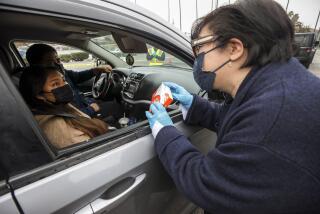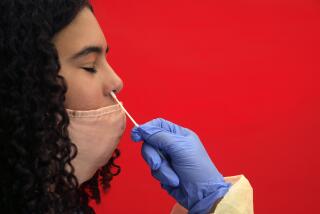Schools could face a hard shutdown if the COVID-19 surge worsens, officials warn

Campuses at public and private schools in Los Angeles County could once again be forced to shut down completely for in-person instruction if the current COVID-19 spike continues to worsen, health officials warned school leaders Thursday.
Officials in the county’s 80 public school districts, which serve more than 1.43 million students, had hoped to open campuses for general instruction by January, if not sooner. Even in the best-case scenario, it would be extremely unlikely that campuses could reopen to all students for at least six weeks, based on state health guidelines, said Los Angeles County Public Health Director Barbara Ferrer.
The schools discussion took place on a day when coronavirus infections in California surpassed 1 million cases, with county rates surging and hospitalizations climbing.
School leaders are being asked to prepare for the worst, even while they ready reopening plans.
“I need to ask that every school be prepared for virtual learning, distance learning, in January,” Ferrer said in a call. “I hope we never get to the point where our healthcare system is so compromised and so threatened that we have to look backwards in time to severe restrictions and additional closures, but I don’t want to rule it out.”
L.A. County’s health data place it firmly in the state’s purple tier — the worst category — which means that community transmission of the coronavirus is widespread. Campuses cannot reopen for all students until a county has entered and remained in the next — or red tier — for two weeks.
In response to skyrocketing infections nationwide, many school districts, including in Wichita, Kan., have imposed new limits on reopening campuses or have shut down again, as in Minneapolis and Boston. Others, including Philadelphia’s school system, have delayed reopening campuses — indefinitely in some instances. Other school systems, including in Florida, remain open or are reopening gradually.
Neither the federal government nor California is collecting comprehensive reopening data.
Brown University researchers have said that so far, the danger of transmission on campus appears minimal — provided that a school is following recommended safety precautions. However, that research has critics and even Brown’s expert said it might be unwise to reopen a campus in an area with widespread community transmission of COVID-19.
Ferrer said she’s not encouraged by what she’s seeing.
“As rough as it’s been for us in the summer months, if we look around the rest of the country, particularly to what’s happening in states where it’s already gotten a lot colder and we look across the world … we are seeing an explosion of cases — like everywhere,” Ferrer said adding that it would be “foolhardy” not to plan for the potential of another total campus shutdown.
However, Ferrer also asked education leaders to prepare for an opposite scenario: a rapid drop in cases that would allow schools to accelerate reopening. In that alternate reality, county waivers could be expanded so that elementary schools could open for all grades. There also could be an expansion in the number of other students allowed to return to campus. Currently, students with special needs can receive services in person, up to 25% of a campus’ enrollment.
Ferrer spoke to school leaders in two calls Thursday and The Times obtained a recording of one briefing.
Education officials told The Times that Ferrer’s update added more uncertainty to a difficult year.
“If you’re a proponent of more restrictive policy regarding school reopening, then you heard that the county could be headed for another lockdown,” said Supt. Alex Cherniss of Palos Verdes Peninsula Unified. “If you’re an advocate for more expansive reopening policy, then you heard that the state and the county would be relaxing guidelines for K-12 schools to reopen.”
Oliver Unaka, a spokesman for Pomona Unified, said the district anticipates “continued updates and changes in the weeks and months ahead.”
L.A schools Supt. Austin Beutner said the district wants “students to return to school as soon as possible in the safest way possible. ... We’re not going to compromise the health and safety of anyone in the school community. So we’re going to be deliberate and we’re going to be careful.”
“Rules that change — we need time to digest,” he said. “Rules that are in conflict — we’re going to err on the side of caution and safety.”
Beutner had already announced that campuses in L.A. Unified, the nation’s second-largest school system, would not reopen before January at the earliest. In the meantime, a small percentage of students are receiving tutoring and the district also is organizing groups of three students at a time for in-person services.
So far, 164 schools have reported coronavirus cases, a tiny fraction of the county’s 3,185 public and private schools, said Dr. Robert Gilchick, the Child and Adolescent Health Section chief for the county health department.
At the affected schools, which were not identified, 169 staff members and 63 students were infected, he said. The county has opened “outbreak investigations” at 13 schools. The county defines a potential outbreak as three or more cases. Virtually all of the affected schools were reporting three or four cases, Gilchick said on the call.
It’s difficult to draw meaningful conclusions from the case information, because no campuses have fully reopened in the county and many have not opened at all. Tens of thousands of students with special needs have gradually returned to campus for services since early October, as have an estimated 8,000 students at schools that received waivers to open for transitional kindergarten through second grade. The vast majority of students are managing most or all of their academic work from home.
For students and parents, Ferrer’s warning was one more frustration.
“The repetitive routine of waking up and being on a computer from 8 in the morning to 1 in the afternoon then only to work on homework or another two to four hours takes its toll,” said Luis Castro-Limon, an 11th-grader and student activist at Diamond Ranch High School.
Ana Laura Portillo, mother of two Pomona students, expressed similar exasperation.
“It’s been eight months of uncertainty, loss of wages, depression, anxiety, fear, illness and loss of education for our children,” she said. “How much more can our community take?”
More to Read
Start your day right
Sign up for Essential California for news, features and recommendations from the L.A. Times and beyond in your inbox six days a week.
You may occasionally receive promotional content from the Los Angeles Times.








